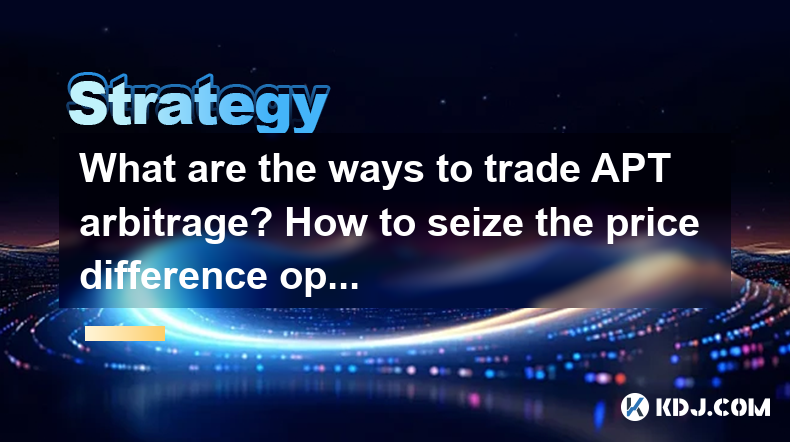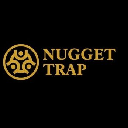-
 bitcoin
bitcoin $114684.631706 USD
-0.87% -
 ethereum
ethereum $4228.677447 USD
1.58% -
 bnb
bnb $1294.880693 USD
-1.16% -
 tether
tether $1.000819 USD
-0.02% -
 xrp
xrp $2.605138 USD
2.79% -
 solana
solana $209.908690 USD
5.89% -
 usd-coin
usd-coin $0.999903 USD
-0.03% -
 dogecoin
dogecoin $0.213423 USD
2.93% -
 tron
tron $0.322721 USD
-0.10% -
 cardano
cardano $0.727247 USD
3.66% -
 hyperliquid
hyperliquid $42.339456 USD
6.05% -
 chainlink
chainlink $19.910811 USD
5.16% -
 ethena-usde
ethena-usde $1.000557 USD
0.00% -
 stellar
stellar $0.349734 USD
2.69% -
 bitcoin-cash
bitcoin-cash $543.848687 USD
-0.21%
What are the ways to trade APT arbitrage? How to seize the price difference opportunities of different platforms?
To profit from APT arbitrage, buy low on one exchange and sell high on another, using real-time data and quick execution to capitalize on price differences.
May 06, 2025 at 12:35 pm

Trading APT (Aptos) arbitrage involves capitalizing on price differences of the cryptocurrency across various trading platforms. This strategy can be profitable but requires a deep understanding of market dynamics, quick execution, and efficient management of funds. Here, we will explore the various ways to trade APT arbitrage and how to seize price difference opportunities on different platforms.
Understanding APT Arbitrage
APT arbitrage is the practice of buying APT on one exchange where the price is lower and simultaneously selling it on another exchange where the price is higher. This difference in price is known as the spread. The goal is to profit from this spread before the prices converge.
To effectively engage in APT arbitrage, traders must have access to real-time price data across multiple exchanges. Additionally, understanding the factors that cause price discrepancies, such as liquidity differences, trading volume, and regional demand, is crucial.
Identifying Price Differences
The first step in APT arbitrage is to identify price differences across platforms. This can be done manually or with the help of automated tools.
Manual Monitoring: Traders can manually check the prices of APT on different exchanges. Websites like CoinGecko or CoinMarketCap provide real-time prices across various platforms. This method is time-consuming but can be effective for those starting out.
Automated Tools: There are numerous arbitrage bots and software available that can monitor price differences across exchanges automatically. These tools can alert traders when a profitable opportunity arises, allowing for quicker execution.
Executing APT Arbitrage Trades
Once a price difference is identified, the next step is to execute the trade. Here’s a detailed process of how to do this:
Open Accounts on Multiple Exchanges: To trade APT arbitrage, you need accounts on the exchanges where you plan to buy and sell. Ensure that you have completed the necessary KYC (Know Your Customer) procedures and have funds ready in your accounts.
Transfer Funds: If you need to transfer funds between exchanges, consider the transfer time and fees. Some exchanges offer faster and cheaper transfer options than others.
Place Orders Simultaneously: To maximize profits, it’s crucial to buy and sell at the same time. This minimizes the risk of the price changing before you can complete the arbitrage. Use limit orders to ensure you get the desired price.
Monitor and Adjust: Keep an eye on the market conditions and adjust your strategy as needed. If the price difference narrows before you can complete the trade, you might need to cancel your orders and wait for another opportunity.
Managing Risks in APT Arbitrage
Arbitrage trading is not without risks. Here are some key risks and how to manage them:
Price Slippage: The price can change between the time you place your buy and sell orders. To mitigate this, use limit orders and consider the liquidity of the exchanges.
Transaction Fees: High transaction fees can eat into your profits. Choose exchanges with lower fees and consider the cost of transferring funds between exchanges.
Execution Speed: The faster you can execute your trades, the better. Automated tools can help with this, but ensure you understand how they work before relying on them.
Regulatory Risks: Ensure that you comply with the regulations of the countries where the exchanges operate. Some jurisdictions have strict rules about arbitrage trading.
Tools and Resources for APT Arbitrage
To enhance your APT arbitrage strategy, consider using the following tools and resources:
Arbitrage Bots: Bots like Gimmer or HaasOnline can automatically detect price differences and execute trades. These can be particularly useful for high-frequency trading.
APIs: Many exchanges offer APIs that allow you to integrate real-time data into your trading strategy. This can help you monitor prices more effectively.
Trading Platforms: Some platforms, like 3Commas or Cryptohopper, offer advanced trading features that can assist with arbitrage, including multi-exchange trading and automated strategies.
Educational Resources: Websites like Investopedia or CryptoQuant provide valuable insights into arbitrage strategies and market analysis.
Seizing Price Difference Opportunities
To effectively seize price difference opportunities, follow these steps:
Stay Informed: Keep up with news and events that can affect APT prices. Factors like exchange listings, partnerships, or regulatory changes can cause price fluctuations.
Analyze Market Trends: Use technical analysis to understand market trends and predict potential price movements. Tools like TradingView can help you with this.
Diversify: Don’t focus solely on APT. Consider arbitrage opportunities with other cryptocurrencies to spread your risk.
Network: Join trading communities and forums to share insights and learn from other traders. Platforms like Reddit or Telegram can be valuable resources.
Continuous Learning: The cryptocurrency market is dynamic, so continuous learning is essential. Stay updated with the latest trading strategies and tools.
Frequently Asked Questions
Q: Can I use leverage for APT arbitrage?A: Yes, some exchanges allow you to use leverage for arbitrage trading. However, this increases your risk, so it's important to understand the implications and manage your exposure carefully.
Q: How much capital do I need to start APT arbitrage?A: The amount of capital required can vary widely. It depends on the minimum trade sizes on the exchanges you use and the fees involved. Starting with a small amount to test your strategy is advisable before scaling up.
Q: Are there any legal concerns with APT arbitrage?A: Legal concerns can vary by jurisdiction. It's important to ensure that you comply with local regulations and the terms of service of the exchanges you use. Some regions may have restrictions on arbitrage trading.
Q: How do I handle withdrawals and deposits for APT arbitrage?A: Efficiently managing withdrawals and deposits is crucial. Use exchanges with fast and low-cost transfer options. Consider keeping funds on multiple exchanges to minimize transfer times and maximize trading opportunities.
Disclaimer:info@kdj.com
The information provided is not trading advice. kdj.com does not assume any responsibility for any investments made based on the information provided in this article. Cryptocurrencies are highly volatile and it is highly recommended that you invest with caution after thorough research!
If you believe that the content used on this website infringes your copyright, please contact us immediately (info@kdj.com) and we will delete it promptly.
- XRP Price Prediction: Weekend Rollercoaster or Rally?
- 2025-10-12 08:45:16
- Bittensor (TAO): Super Bullish Signals Point to Potential 2x Rally
- 2025-10-11 10:25:12
- Silver Price Correction: Navigating the Dip & Identifying Key SEO Keywords
- 2025-10-11 10:25:12
- Decoding Crypto Trends: Bittensor's Bull Run, Cardano's Dip, and LivLive's Presale Buzz in 'Uptober 2025'
- 2025-10-12 08:45:16
- MoonBull: The Crypto Meme Coin Promising 1000x Gains?
- 2025-10-11 10:30:01
- Crypto Payroll Revolution: Stablecoins, Altcoins, and the Future of Salary Payments
- 2025-10-11 10:30:01
Related knowledge

Practical parameter settings for a Bitcoin multi-timeframe moving average system
Sep 18,2025 at 10:54pm
Optimizing Timeframe Combinations for Bitcoin Trading1. Selecting appropriate timeframes is crucial when building a multi-timeframe moving average sys...

How can I filter out false breakouts in Dogecoin high-frequency trading?
Sep 22,2025 at 01:00am
Understanding False Breakouts in Dogecoin Trading1. A false breakout occurs when Dogecoin's price appears to move beyond a defined support or resistan...

Techniques for identifying tops and bottoms in the Bitcoin on-chain NVT model
Sep 20,2025 at 07:54pm
Understanding the NVT Model in Bitcoin Analysis1. The Network Value to Transactions (NVT) ratio is often described as the 'P/E ratio' of the cryptocur...

What does the surge in open interest in Bitcoincoin futures mean?
Sep 20,2025 at 11:18pm
Understanding the Surge in Dogecoin Futures Open Interest1. A surge in open interest within Dogecoin futures indicates a growing number of active cont...

How can I use the Ethereum USDT premium to gauge market sentiment?
Sep 18,2025 at 11:55pm
Understanding the Ethereum USDT Premium1. The Ethereum USDT premium refers to the price difference between USDT (Tether) traded on Ethereum-based plat...

What should I do if Ethereum staking yields decline?
Sep 20,2025 at 06:18am
Understanding the Causes Behind Declining Ethereum Staking Yields1. The Ethereum network transitioned to a proof-of-stake consensus mechanism with the...

Practical parameter settings for a Bitcoin multi-timeframe moving average system
Sep 18,2025 at 10:54pm
Optimizing Timeframe Combinations for Bitcoin Trading1. Selecting appropriate timeframes is crucial when building a multi-timeframe moving average sys...

How can I filter out false breakouts in Dogecoin high-frequency trading?
Sep 22,2025 at 01:00am
Understanding False Breakouts in Dogecoin Trading1. A false breakout occurs when Dogecoin's price appears to move beyond a defined support or resistan...

Techniques for identifying tops and bottoms in the Bitcoin on-chain NVT model
Sep 20,2025 at 07:54pm
Understanding the NVT Model in Bitcoin Analysis1. The Network Value to Transactions (NVT) ratio is often described as the 'P/E ratio' of the cryptocur...

What does the surge in open interest in Bitcoincoin futures mean?
Sep 20,2025 at 11:18pm
Understanding the Surge in Dogecoin Futures Open Interest1. A surge in open interest within Dogecoin futures indicates a growing number of active cont...

How can I use the Ethereum USDT premium to gauge market sentiment?
Sep 18,2025 at 11:55pm
Understanding the Ethereum USDT Premium1. The Ethereum USDT premium refers to the price difference between USDT (Tether) traded on Ethereum-based plat...

What should I do if Ethereum staking yields decline?
Sep 20,2025 at 06:18am
Understanding the Causes Behind Declining Ethereum Staking Yields1. The Ethereum network transitioned to a proof-of-stake consensus mechanism with the...
See all articles










































































